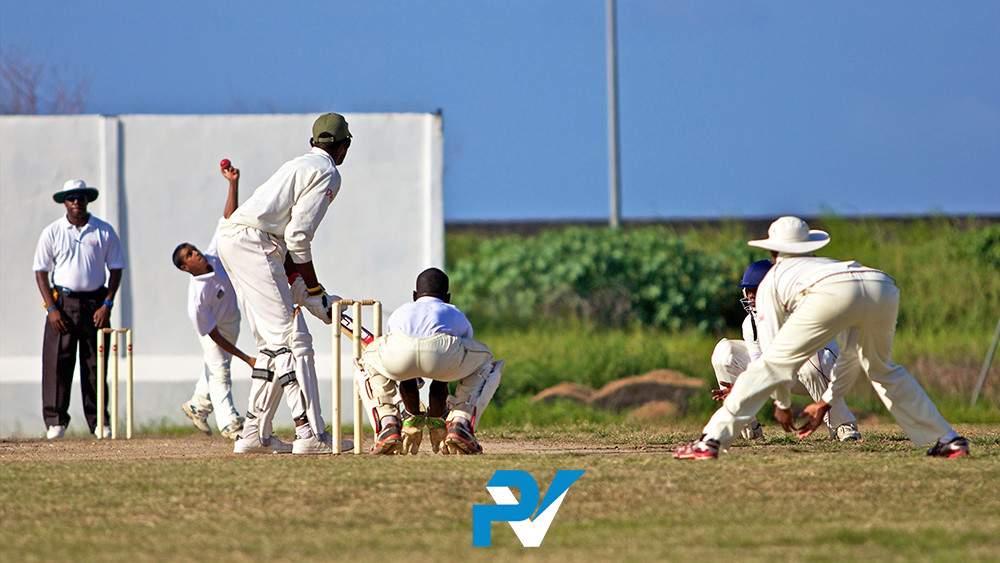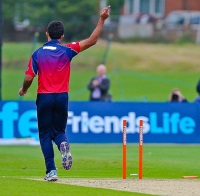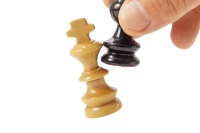Video: Analyse Spin Bowling Technique
Here's a video of a one to one session with a spinner using PitchVision to provide analysis.
In this session we took a look at a player who wanted to add a string to his bow as a bowler, and wasn't sure exactly of his strengths and weaknesses. So over the course of 70 balls, I combined good old watching him bowl with reviewing the video of his action and combined it with the pace, turn and accuracy outcomes we saw on PitchVision.
The Importance of the Braced Front Leg for Spinners
 This is a guest article from Max Andrews
This is a guest article from Max Andrews
Bracing up with your front leg after front foot landing is absolutely critical for exploiting maximum control, speed and spin.
Improve Your Bowling Accuracy With the Right Focus
 Target bowling is one of the most used drills by bowlers to improve accuracy: Lay cones on a length, try to hit them, track you progress.
Target bowling is one of the most used drills by bowlers to improve accuracy: Lay cones on a length, try to hit them, track you progress.
However, an often overlooked aspect of target practice is where you focus.
There are many options, but when the coach tells you to "look where you want the ball to pitch" he or she is not giving you the whole story.
Advanced Target Practice for Bowlers: PV/ONE Drill
Target bowling for cricket is a good practice that has several problems. All can be overcome with the drill in this video.
Click below to view:
If you can't see the video, click here.
Using PitchVision, bowlers can bowl in nets at a target with a batsmen to put them off and no visual cues. This is far more realistic.
Tactics You Should Be Using: Bowl at the Stumps
 Does it seem a bit old fashioned to say "pitch it up, hit the stumps"?
Does it seem a bit old fashioned to say "pitch it up, hit the stumps"?
In these days of slower ball bouncers, enforcers and bowling dry outside off stump you might think so. Actually, it's still an effective way to bowl in most situations.
Swing bowler on a slow English pitch in May? Yes.
Spinner on a Bunsen burner? Absolutely.
Fast bowler on a flat deck? Without doubt.
How to Prepare for Bowling into the Rough

One of the features of this Ashes series will be the battle between spinner and batters as the rough patches develop rapidly through each Test match. The weather in the UK has been (relatively) dry for months. The pitches are drier than usual for this time of year.
The Australian left arm seamers will help the rough patches to degrade at an accelerated rate outside the right handed batters off stump. This shall bring Moeen Ali and Nathan Lyon into the game earlier as attacking forces. It is likely that the Stokes, Anderson, Broad and Wood will bowl some overs around the wicket at David Warner, if he stays in long enough. This will also add wear and tear to that rough area.
The developing rough isn't just a problem for the batter. It also creates challenges for the keeper and the bowler as well. I know what you're saying; "Test match spinners shouldn't be challenged by the rough? It should be all their dreams come true!"
For bowlers such as Murali or Warne the rough represented opportunity. For most spinners, the developing footholds can represent a threat.
This threat is the pressure of expectation.
What are Good Areas?
Sam Lavery has been thinking about a good line and length, and he's not happy with the term. Read on for his solution.
"Just hit good areas".
That's a phrase I hear almost every day as coach. Whether it's bowlers, batsmen or coaches, "good areas" is a term used widely used but often blindly.
Video: How to Practice Bowling Under Pressure
There is a world of difference between bowling in practice, and bowling under match pressure. If you are going ot be a good bowler, you need to be able to handle the latter. So, here's a simple drill you can do to add pressure to your net sessions.
Here's the video so you can see it in action:
If you can't view it above, click here.
How to Bowl Line and Length with This Accuracy Net Drill
 Even today, where there are a hundred different types of ball, good old-fashioned line and length bowling is an incredibly effective way to bowl: Hit the spot, do a bit off the pitch or in the air, take wickets. Simple.
Even today, where there are a hundred different types of ball, good old-fashioned line and length bowling is an incredibly effective way to bowl: Hit the spot, do a bit off the pitch or in the air, take wickets. Simple.
Yet it's also a world of pain to do consistently.
Sure, you bowl in nets as much as you can. You put up with slogging batsmen and you take time to work on your action.
Then you get out into a game and bowl two four balls every over, wondering where it all went wrong.
What's going on?
It's not the puzzle you think, but it does take some work on your part. It's easy improve your accuracy (and pace at the same time) with a simple process.
2 Simple Drills to Improve Your Spin Bowling Flight and Guile

"He approaches the wicket and releases the ball. I'm about to find out what it's really like to face a top class bowler.
It hangs there in the air.If someone bowled a ball like this to me in a Baldwin match, I'd probably stop it with my glove, sling it back to the bowler and tell him, 'Never mind, have another go...' In fact, I might say it anyway, once it's been retrieved from the far stands.
Perhaps age has caught up with the Indian master. Or perhaps he was never quite as good as we all thought. Perhaps none of them are.
But then something inexplicable occurs. The ball, having seemed suspended in the air from some invisible string with the words 'Hit Me' on it, suddenly dips and loops at the last second. It pitches just short of a length, spits like a cobra and climbs at a scientifically unfeasible angle. Striking the outside edge of my bat it balloons gently into the air and is caught with pathetic ease by the wicketkeeper."
You won't find many better descriptions of a master spinner totally deceiving a batsman than that. The great Bishan Bedi at work.
Mastery of flight or loop can take many years. However you can speed up the process with some simple practice methods that can be done alone.

